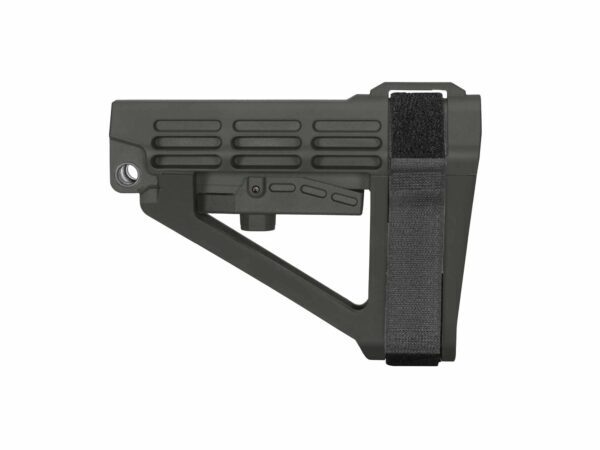If you’ve been following the gun world over the past decade, you’ve probably heard about pistol braces—those nifty little accessories that turned AR-style pistols into something a bit more stable and user-friendly. But what started as a simple tool for shooters with disabilities has turned into one of the most controversial topics in firearms law. Here’s the full story, from their humble beginnings to the courtroom drama that’s still unfolding.
What Is a Pistol Brace, and Why Does It Matter?
For those still asking, “What is a pistol brace?”—it’s a device designed to help stabilize a pistol, particularly AR-style pistols, while shooting. Unlike a traditional stock, a pistol brace is intended to strap to your forearm, though its design has sparked debates over pistol brace vs stock usage.
Pistol braces might seem like a niche issue, but they’ve become a flashpoint in the broader debate over gun rights and government overreach. For gun owners, it’s about more than just a piece of plastic—it’s about the right to own and use firearms without fear of arbitrary regulations.

2012: The Birth of the Pistol Brace
Pistol braces first hit the scene in 2012, thanks to a company called SB Tactical. The idea was simple: create a stabilizing device that could help people with disabilities or limited mobility shoot AR-style pistols more comfortably. The brace straps to your forearm, giving you better control when firing one-handed.
At first, the Bureau of Alcohol, Tobacco, Firearms and Explosives (ATF) gave the green light, saying that attaching a pistol brace to a pistol didn’t turn it into a short-barreled rifle (SBR)—a heavily regulated category under the National Firearms Act (NFA). This was a big deal because SBRs require a $200 tax stamp, a background check, and a whole lot of paperwork.
2014–2020: The ATF’s Back-and-Forth
For years, the ATF sent mixed signals about pistol braces. They issued a bunch of opinion letters saying braces were fine as long as you weren’t intentionally using them as shoulder stocks. But they also warned that modifying a brace to function like a stock could land you in hot water.
This created a lot of confusion. Gun owners and manufacturers were left scratching their heads, wondering what was legal and what wasn’t. Meanwhile, pistol braces became wildly popular, with millions sold across the country. The debate over pistol brace vs stock usage also began to heat up, as some argued that braces were being used to skirt SBR regulations.
2020–2021: The ATF Drops a Bombshell
In December 2020, the ATF proposed a new rule that would’ve reclassified many pistols with braces as SBRs. The idea was to create a set of criteria—like weight, length, and design—to determine whether a braced pistol was really meant to be fired from the shoulder.
The proposal sparked outrage. Gun owners, manufacturers, and Second Amendment advocates argued that the ATF was overstepping its authority and punishing law-abiding citizens. Millions of people submitted comments opposing the rule, but the ATF pressed on.
January 2023: The ATF’s Final Rule
In January 2023, the ATF dropped the hammer. Their final rule reclassified most pistols with pistol braces as SBRs, meaning owners had to either:
-
Register their firearms with the ATF (and pay the $200 tax stamp).
-
Remove the pistol brace and turn their gun back into a regular pistol.
-
Surrender or destroy the firearm.
The rule was a nightmare for gun owners. Overnight, millions of people found themselves in legal limbo. Lawsuits flooded the courts, with groups like the Firearms Policy Coalition (FPC) and Gun Owners of America (GOA) leading the charge.
2023–2024: Courts to the Rescue
The legal battles heated up fast. In November 2023, the Fifth Circuit Court of Appeals issued a nationwide injunction, putting the ATF’s pistol brace rule on hold. Then, in June 2024, a federal judge in Texas ruled that the ATF’s rule was “arbitrary and capricious” and struck it down entirely.
The ATF appealed, but in August 2024, the Eighth Circuit Court of Appeals upheld the decision. For the time being, pistol braces were back in business.
2025: Where Things Stand Today
As of early 2025, pistol braces are legal at the federal level, thanks to those court victories. But the fight isn’t over. The Department of Justice is still pushing to reinstate the ATF’s rule, and the case could eventually land in the Supreme Court.
Meanwhile, some states—like California—have passed their own laws restricting pistol braces, creating a patchwork of regulations across the country. The firearms industry has bounced back, with manufacturers ramping up production of AR pistol braces and retailers restocking shelves. But the uncertainty has left many gun owners wondering what’s next.
As the legal battles continue, one thing’s for sure: the story of pistol braces is far from over. Whether you love them or hate them, they’ve left a lasting mark on the gun world—and the fight for the Second Amendment.
At Timbervaults, we understand the importance of protecting your firearms while staying prepared for any situation. Just as pistol braces have evolved to meet the needs of gun owners, our expertly crafted concealment furniture offers stylish and secure storage for your firearms. Whether you own an AR pistol brace setup or a handgun, our products blend seamlessly into your home while keeping your firearms accessible for rapid access. Discover our collection today and elevate your firearm storage with Timber Vault.




